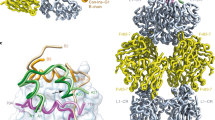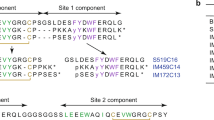Abstract
The insulins of New World hystricomorph rodents exhibit many novel amino acid changes in primary structure when compared with other mammalian insulins1–3. These changes give rise to unusual properties (low potency, failure to self-associate4–6) not shared by other naturally-occurring insulins. We report here on the primary structure, zinc-binding properties and circular dichroism (CD) of porcupine insulin (Hystrix cristata), the first Old World hystricomorph insulin to be investigated, and discuss the changes in primary structure of the hormone in relation to its properties. Residue B22 is strongly implicated as being responsible for the unusual properties of porcupine insulin.
This is a preview of subscription content, access via your institution
Access options
Subscribe to this journal
Receive 51 print issues and online access
$199.00 per year
only $3.90 per issue
Buy this article
- Purchase on Springer Link
- Instant access to full article PDF
Prices may be subject to local taxes which are calculated during checkout
Similar content being viewed by others
References
Blundell, T. L. & Wood, S. P. Nature 257, 197–203 (1975).
Smith, L.F. Diabetes 21, Suppl. 2, 457–460 (1972).
Horuk, R. et al. Nature 279, 439–440 (1979).
Zimmerman, A. E., Kells, D. I. L. & Yip, C. C. Biochem. biophys. Res. Commun. 46, 2127–2133 (1972).
Wood, S. P., Blundell, T. L., Wollmer, A., Lazarus, N. R. & Neville, R. W. J. Eur. J. Biochem. 55, 531–542 (1975).
Horuk, R. et al. in Hormones and Cell Regulation (eds Dumont, J.E. & Nunez, J.) (Elsevier, Amsterdam, in the press).
Peterson, J. D., Steiner, D. F., Emdin, S.O. & Falkmer, S. J. biol. Chem. 250, 5183–5191 (1975).
Blundell, T. L., Hodgkin, D. C., Dodson, G. G. & Mercola, D. Adv. Protein Chem. 26, 279–402 (1972).
Goldman, J. & Carpenter, F. H. Biochemistry 13, 4566–4574 (1974).
Zimmerman, A. E. & Yip, C. C. J. biol. Chem. 249, 4021–4025 (1974).
Wood, S. P. thesis, Univ. Sussex (1976).
Emdin, S. O., Gammeltoft, S. & Gliemann, J. J. biol. Chem. 252, 602–608 (1977).
Sönksen, P. H. Nature 282, 11–12 (1979).
Pullen, R. A. et al. Nature 259, 369–373 (1976).
Zimmerman, A. E., Moule, M. L. & Yip, C. C. J. biol. Chem. 249, 4026–4029 (1974).
Cutfield, J. F. et al. J. molec. Biol. 132, 85–100 (1979).
Wood, A. E. in The Biology of Hystricomorph Rodents (eds Rowlands, I. W. & Weir, B.J.) 21–51 (Academic, London, 1974).
Author information
Authors and Affiliations
Rights and permissions
About this article
Cite this article
Horuk, R., Blundell, T., Lazarus, N. et al. A monomeric insulin from the porcupine (Hystrix cristata), an Old World hystricomorph. Nature 286, 822–824 (1980). https://doi.org/10.1038/286822a0
Received:
Accepted:
Published:
Issue Date:
DOI: https://doi.org/10.1038/286822a0
This article is cited by
-
Intein-mediated recombinant expression of monomeric B22Asp desB30 insulin
BMC Biotechnology (2020)
-
Looking at the carcinogenicity of human insulin analogues via the intrinsic disorder prism
Scientific Reports (2016)
-
Differential binding of sulphated insulin to adipocytes and hepatocytes
Diabetologia (1984)
Comments
By submitting a comment you agree to abide by our Terms and Community Guidelines. If you find something abusive or that does not comply with our terms or guidelines please flag it as inappropriate.



